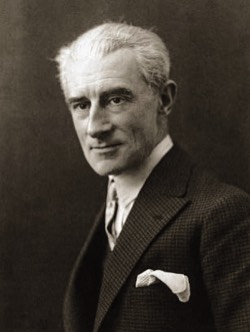MAURICE RAVEL
1875 - 1937
Ravel was born in Ciboure, part of the French Basque region. His mother was Basque, while his father, was a Swiss inventor. At age seven, Ravel began piano lessons and, five or six years later, began composing. His parents encouraged his musical pursuits and sent him to the Conservatoire de Paris and studied music under Gabriel Fauré for a remarkable fourteen years.
During his years at the Conservatoire, Ravel tried numerous times to win the prestigious Prix de Rome, but to no avail. After a scandal involving his loss of the prize in 1905, Ravel left the Conservatoire. While many critics claim Ravel was influenced by composer Claude Debussy, Ravel himself claimed he was much more influenced by Mozart and Couperin. He was also highly influenced by music from around the world, including jazz and folk songs. Though Maurice considered his small size and light weight an advantage to becoming a pilot, during the First World War, Ravel was not allowed to enlist as a pilot because of his age and weak health.
He worked with ballet choreographer Diaghilev who staged Ma mère l’Oye and Daphnis et Chloé. The latter was commissioned by Diaghilev with the lead danced by the great Nijinsky. Stravinsky once described Ravel as "the Swiss watchmaker" of music, because of Ravel's painstaking attention to detail. Ravel himself described a work of art as "a ripened conception where no detail has been left to chance". In 1920, the French government awarded him with the Légion d’honneur, but Ravel refused.
In 1928, Ravel for the first time began a piano tour in America. His numerous concerts and piano recitals received an enthusiastic reception, and he was introduced to celebrities from the worlds of art. He also met George Gershwin and the two became friends. Ravel's admiration of American jazz led him to include some jazz elements in a few of his later compositions, especially the two piano concertos. Ravel made one of his few recordings when he conducted his Bolero with the Lamoureux Orchestra in 1930.
His few students included Maurice Delage, Manuel Rosenthal and Ralph Vaughan Williams. In 1932 Ravel was involved in an automobile accident that severely undermined his health. His output dropped dramatically. In 1937 he had a neuro-operation that he hoped would restore much of his health, but the operation was a failure. On 28 December, 1937, Ravel died in Paris.
Selected Tracks
Bolero
The composition, commissioned by the celebrated Russian ballerina Ida Rubenstein, moves with a persistent Spanish dance rhythm and is constructed on just two musical phrases repeated with an obsessive, constant movement of melody and tonality. Bolero was first performed in Paris in November 1928, and the ballet, being very original and provocative, obtained clamorous success.
Ravel pointed out: “Both the theme and the accompaniment are my inventions, although they both have a Spanish quality to them. I’ve always had a weakness for everything regarding Spain. In fact, I was born right at the border, and then there’s another reason: my parents met in Madrid.”
Ma mère l’Oye
A collection of “five infantile pieces”, the orchestral version was composed in 1911 and won undying fame. Nevertheless, the original version is for four-hand piano published in 1910 and dedicated to Mimie and Jean, children of the Godebskis, intimate friends of Ravel. The collection was inspired by some 17th century French fairytales. In a letter addressed to the very young Jeanne Leleu, the first who performed the collection, Ravel wrote: “Thanks a million for your childish and spirited interpretation of Ma mère l’Oye, and believe young lady, in the sentiments of recognition from your devoted Marcel Ravel.”
Introduction et Allegro
Introduction et allegro for harp, flute, clarinet and string quartet was composed very quickly in June 1905. The firm Erad had commissioned the work from Ravel in order to support the sales of a new model of harp with a pedal. The work is unjustly considered a minor production of the French composer. In one of his letters, Ravel wrote: “I have been terribly busy for a few days before my departure due to a composition for a harp commissioned by the firm Erad. A week of frenetic work and three nights without sleep allowed me to finish it, in a good or bad way.”
Rapsodie Espagnole
The first version of the Rapsodie was for two pianos composed during the summer of 1907, rapidly followed by a renowned transcription for orchestra. The work reflects the profound influence of the Spanish musical heredity that was transmitted to him by his mother who was of Basque origin.
Speaking of Habanera, originally written for two pianos in 1895, Ravel specified: “I believe this work contains the embryo of the different elements that would predominantly appear in my successive compositions.”
La Valse
This “choreographic poem”, originally commissioned by Sergej Diaghilev, was composed between December 1919 and April 1920. The first version for two-hand piano was quickly substituted by a second version for two pianos, accurately elaborated; from the latter, the orchestral transcription that made the work famous was contrived. Ravel’s written treatment of the ballet reads: Clouds whirling lets one glimpse at couples dancing the Waltz. Little by little, the clouds dissolve: an immense room appears, populated by a swirling crowd. The scene slowly becomes clearer. At the fortissimo, lamplights shine. Set in an Imperial Court, about 1855.
Ravel 2 by A. Stella and G. Tomassi





